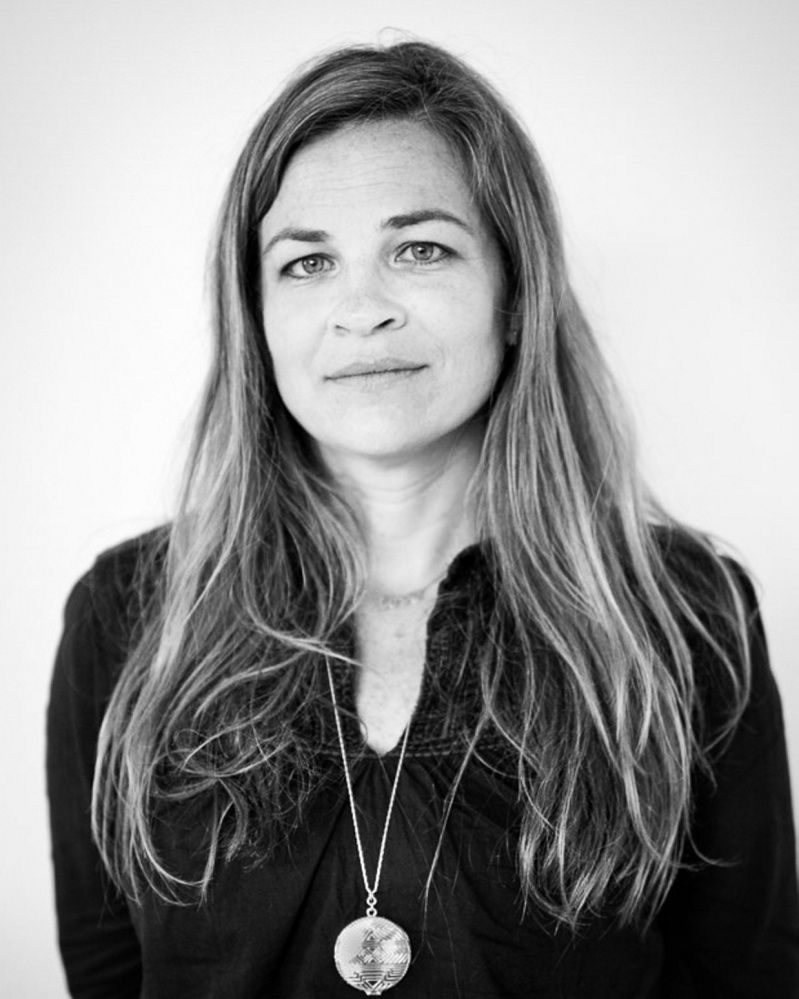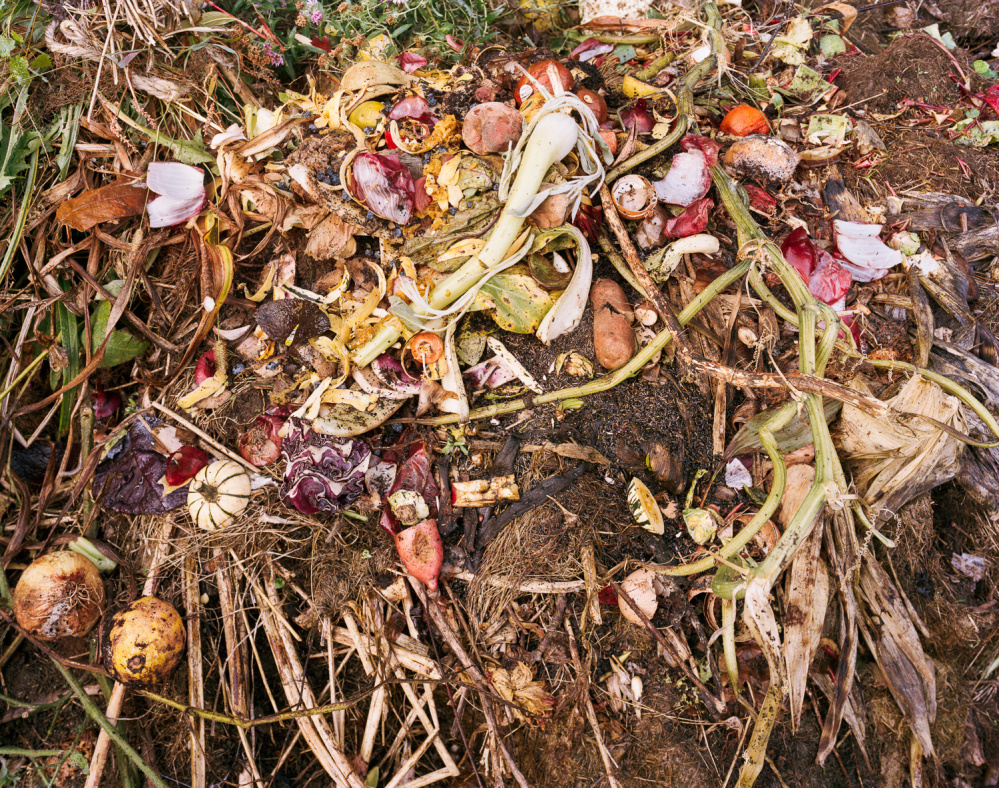“You Can’t Get There From Here: The 2015 Portland Museum of Art Biennial” includes two large photographs of faded grasses, rotting fruit, eggshells and onion skins. It’s compost, but they go by a more evocative name, “Reclamation,” and they are the work of a Boston-based photographer named Christine Collins. We called her up to talk about her interest in sustainability, how Michael Pollan’s “Omnivore’s Dilemma” influenced both her eating habits and her art and the surprising allure of well-lit compost.
BEES IN THE BURBS: This isn’t Collins’ first nature series. In 2010 she started photographing beekeepers in suburban areas. “I am interested in these representations of nature and the natural world within our domestic sphere,” she said. Particularly in the suburbs, where the natural world is so boxed in. She read Pollan’s “Omnivore’s Dilemma” shortly after it came out and felt an intersection between the way he wrote about our relationship with food and nature and the way she was feeling. “He is not proselytizing about it. He is questioning too, our relationship to the landscape and the whole supermarket pastoral. The narrative of the organic movement that has kind of a soothing effect on us.” In contrast to that soothing effect is the reality of how little time most Americans spend outside.
MAINE CONNECTION: Collins grew up in New York City and spent summers on Long Island. “I had this kind of dual upbringing,” she said. “Part city, part country, and when I moved to Maine, I really connected to the landscape. I always joke that I am trying to make every landscape look like the Maine landscape.” She came to the state in the mid-1990s to study photography in Rockport in what is now known as the Maine Media Workshops. It is where “I became an artist,” she said. She also lived in York for awhile. “I keep looking for ways to get back,” she said wistfully. “There are a lot of people for whom Maine is kind of a creative well.” For now, she and her husband, also an artist, and their children are in Boston, where she teaches photography at Lesley University.
STUMBLING INTO THE SHOT: Collins was working on her series about beekeepers when she stumbled into her next topic. She was backing up to frame a shot of two beekeepers, one of whom was eight months pregnant, tending their hive in their backyard in Stowe, Massachusetts. “My foot hit something squishy and I turned to look and there was the compost pile,” she said. “I was just kind of amazed at how beautiful it was. And how strange and wild looking.”
MAY I? She asked permission to train her large format 4×5 field camera on the pile. Did the beekeepers think her request was a little odd? No, because they were acquaintances through photography circles. The compost pile is deep in a backyard shared by another family. “When I got the film back I just loved the way that it looked – the idea of the reference to the still life tradition that I saw in it. How it fit into the things I had been thinking about, the cycles of time in relationship to nature.”
She had been reading a book by Paul Harding called “Tinkers” (a Pulitzer Prize winner in 2010). “The book is about how we measure our lives,” Collins said. “And the passage of time … there is a quote where he is talking about a kind of consciousness that is not accessible through words but through grass and flowers and light and shadow. I loved that idea.”
BACK TO THE DUMP: The more she returned to shoot the pile in various stages and seasons, the more she realized how it fit in with the work she’d already been doing, particularly with the beekeeper series. Photographing the pile went from an intuitive process to an intentional one. She’s not quite done with the beekeepers’ compost either. “I went back really recently, in the last week, although I don’t know that I love the picture that I made there.” But she does love the way the pile changes seasonally and represents the lives and habits of its suburban owners. “When they put their garden to bed before winter, they throw everything in there. It becomes the receptacle of the way they tend to their space.”
WHAT’S IN A NUMBER? The two photographs from the “Reclamation” series are numbered 54 and 15 (that’s #54 depicted here). No, there are not 54 images in the series. “It’s my own numbering system,” Collins said, laughing. These almost baroque images imply a connection to the landscape and romantic imaginings of where the vegetables come from. Like sweet little farms run by salt-of-the-earth types? Yes, but “you do see grocery store stickers in there.” She doesn’t intend them as a criticism but rather a way to point out the contradiction in the pastoral image. Collins ponders the issue of how completely anyone can “live locally” in the modern era. Where does she fall in the back-to-the-land versus back-to-the-city-block question? “I am in the camp of being in the middle.”
NEXT UP: Collins has a new image on her website (christinemcollins.com) of compost strewn across a oilskin tablecloth, one of those cheery ones with fruits printed on it. A sheet of clear plastic ripples through the mess.
“I am starting to be interested in these idealized visions of food,” she said. “This image is compost from our house, part of that is being interested in shifting the conversation and implicating myself a little more in that I know that is my food. But then also, there is plastic. I am thinking a lot about preservation, too.”
“I think about sustainability,” she added carefully. “How it refers to a lot of different things. In our culture right now there is a sort of romanticized vision of sustainability. And there is a conversation woven into that about privilege and the time and wherewithal to think about that. For a lot of us, it is about negotiating a kind of balance. And yeah, those bananas were shipped from somewhere else.”
Send questions/comments to the editors.





Success. Please wait for the page to reload. If the page does not reload within 5 seconds, please refresh the page.
Enter your email and password to access comments.
Hi, to comment on stories you must . This profile is in addition to your subscription and website login.
Already have a commenting profile? .
Invalid username/password.
Please check your email to confirm and complete your registration.
Only subscribers are eligible to post comments. Please subscribe or login first for digital access. Here’s why.
Use the form below to reset your password. When you've submitted your account email, we will send an email with a reset code.